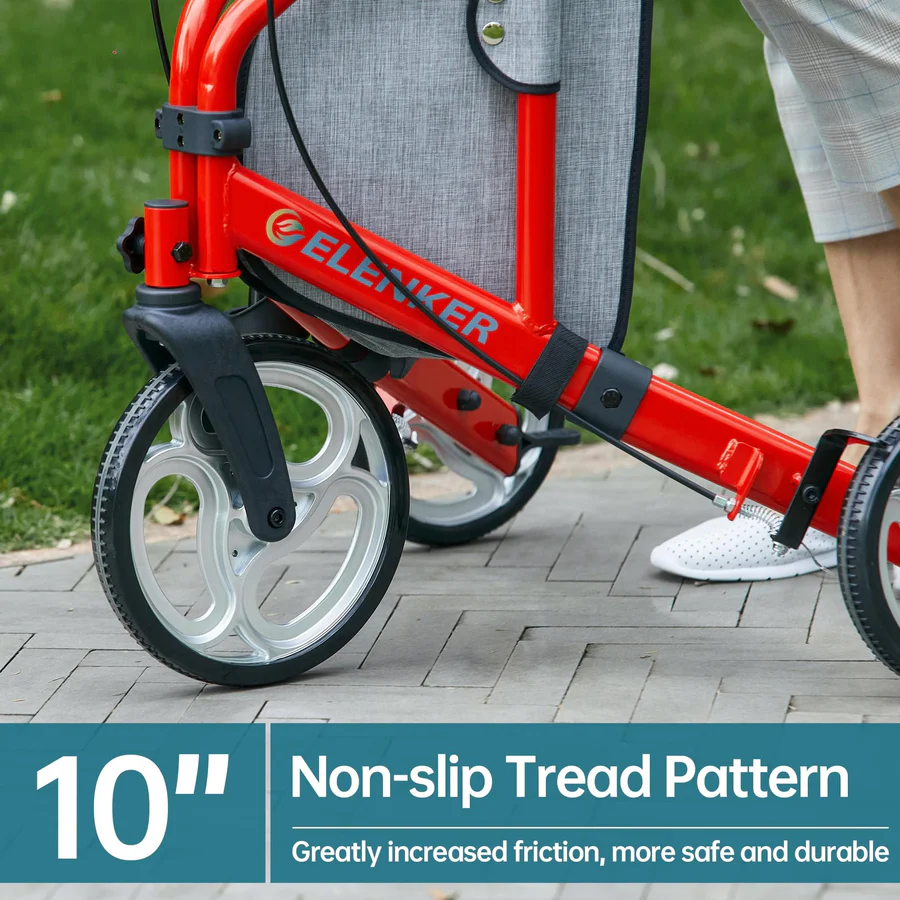If you’re in the market for a walker, you’ve probably come across two main types: the 3-wheel rollator walker and the 4-wheel walker. At first glance, they might seem pretty similar—both help with balance and mobility, and both have wheels to make walking easier. But when you take a closer look, there are some key differences that can make one better suited for your needs than the other. Let’s break it all down so you can figure out which one is the right choice for you.
What Is a 3-Wheel Walker?
A 3-wheel rollator walker, as the name suggests, has three wheels—one in the front and two in the back. It’s designed for people who need some extra balance and support while walking but still want a lightweight, maneuverable option.
One of the biggest benefits of a 3-wheel walker is its slim design. Because it has only three wheels, it’s typically narrower than a 4-wheel walker, making it great for tight spaces like narrow hallways, crowded stores, or small apartments.
Many 3-wheel rollator walkers also come with storage pouches or baskets, making it easy to carry personal items, groceries, or anything else you need while on the go. However, one key difference between a 3-wheel walker and a 4-wheel walker is that most 3-wheel walkers do not come with a built-in seat. This means they’re better suited for people who don’t need to stop and rest often.

What Is a 4-Wheel Walker?
A 4-wheel walker, on the other hand, has four wheels—two in the front and two in the back. These walkers are more stable than 3-wheel rollator walkers, making them a great option for people who need extra balance support.
Most 4-wheel walkers (especially Elenker rollators) come with a built-in seat, so if you need to rest frequently, this is a huge advantage. Just imagine being out for a walk or running errands and getting tired—you can just lock the brakes, sit down, and take a break whenever you need to.
Since 4-wheel walkers have a wider frame, they provide better stability than a 3-wheel walker, but they can be harder to maneuver in small spaces. If you live in a house with narrow hallways or frequently navigate crowded areas, a 3-wheel rollator walker might be a better choice.

Comparing the Two: Which One Is Right for You?
Now that we’ve gone over the basics, let’s compare 3-wheel walkers and 4-wheel walkers side by side.
1. Maneuverability
- 3-wheel rollator walker: Because of its triangular shape, it’s much easier to turn and navigate around tight corners. It’s a great choice for indoor use, especially in small homes or apartments.
- 4-wheel walker: While still easy to move, a 4-wheel walker is a bit wider and bulkier, which can make it harder to get through tight spaces. However, it rolls more smoothly on outdoor surfaces.
2. Stability
- 3-wheel walker: Offers good support but is less stable than a 4-wheel walker because of its three-point design. It’s great for people who need light support but still have good balance.
- 4-wheel walker: Provides better stability, especially for those who need extra balance assistance. The wider base helps prevent tipping.
3. Weight & Portability
- 3-wheel rollator walker: Generally lighter than a 4-wheel walker, making it easier to fold and transport.
- 4-wheel walker: Heavier than a 3-wheel walker but still foldable for transport. If you have trouble lifting, a 3-wheel walker might be the better choice.
4. Seating & Comfort
- 3-wheel walker: No seat, so it’s not ideal for people who need frequent breaks while walking.
- 4-wheel walker: Comes with a built-in seat, allowing users to rest whenever needed. Many walkers with seats, like Elenker walkers, also have padded backrests for extra comfort.
5. Storage & Extras
- 3-wheel rollator walker: Often includes a small pouch or basket for storage but typically less space than a 4-wheel walker.
- 4-wheel walker: Usually has larger storage compartments, making it easier to carry bags, groceries, or medical supplies.
6. Terrain & Outdoor Use
- 3-wheel walker: Works best indoors or on smooth surfaces. The smaller frame and lighter design make it easy to use in homes or stores but less ideal for rough terrain.
- 4-wheel walker: Better for outdoor use, especially on sidewalks, parks, or uneven ground. The four-wheel design helps it roll smoothly over different surfaces.
Who Should Get a 3-Wheel Walker?
A 3-wheel rollator walker is best for:
✅ People who need lightweight support and good maneuverability.
✅ Those who live in small spaces and need a narrow walker to fit through doors and hallways.
✅ Individuals who don’t need to sit and rest while walking.
✅ Those looking for a walker that’s easy to transport and store.
Who Should Get a 4-Wheel Walker?
A 4-wheel walker is best for:
✅ People who need extra stability and support.
✅ Those who get tired easily and need a seat to rest.
✅ Individuals who walk outdoors often and need a walker that can handle different terrains.
✅ Seniors who want larger storage space for personal items.
Choosing between a 3-wheel walker and a 4-wheel walker depends on your mobility needs, lifestyle, and how you plan to use it. If you want something lightweight and easy to maneuver, go for a 3-wheel rollator walker. But if you need extra stability and a place to sit, a 4-wheel walker—like one of the Elenker rollators—is a better choice.
Either way, both walkers for seniors provide valuable support, making everyday movement safer and more comfortable. Whether you need a rolling walker for indoor use or one that can handle outdoor adventures, there’s an option out there that’s perfect for you!
